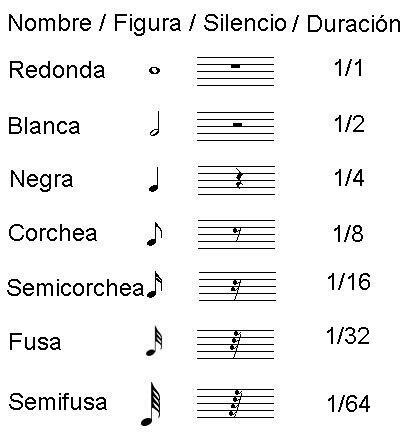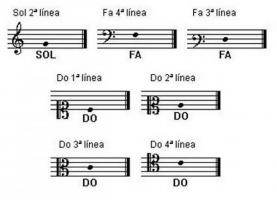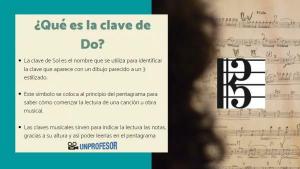What are musical units of TIME

Image: Pinterest
Much more than an art, music is a phenomenon based on the science of sound and its properties. As such, when studying it we require the analysis of other areas such as mathematics, which helps us understand the infinite possibilities of music with numbers. Time, another phenomenon that we can measure with numbers, is an important part of music as well. In this lesson from a TEACHER you will learn about themusical time units, one of the crucial elements for music theory.
Index
- What is a musical unit?
- The different units of musical time
- What are musical time units for?
What is a musical unit?
To understand musical time units it is important that we know what a musical unit is. It is an element that indicates a base figure for the rhythm or the subdivision of a work or song; for musical figurewe understand a note that has a duration specific.
The musical unit allows us to define structural concepts of rhythm such as the metrics or time signature, which are defined by the construction of the rhythm.
Rhythm
Rhythm it is made up of 2 or more notes when they are one after the other. Even when we do not have defined notes in tuning, such as when we play a drum or any percussion instrument (which do not have a melodic or harmonic function). The combination of all these musical figures of different values allows us to create interesting rhythms, which provide diversity to the music.
Time Signature (Metric)
The time signature (or meter) is what tells us how many notes we can have in a measure and their duration. It is thanks to this that we can also infer the type of musicality that the musical phrases of a work carry. We can know the type of time signature with a number placed just at the beginning of a score on the staff, which is represented in the form of a fraction number.
The number at the top is by name numerator and indicates the pulse, which is the amount of “beats” that a measure can have. Finally, the bottom number of the fraction is called denominator and indicates the base musical figure, which is also the unit of musical time.

Image: TIC Music School
The different units of musical time.
Since the units of musical time are based on the musical figures and their duration, we must learn the values of each figure. We call the unit of musical time like this, “weather” (1 beat, 2 beats, 4 beats, etc.).
We will take as a reference a 4/4 time signature, which has 4 beats. For example, if the musical figure of the black has the duration value of 1 time in the bar and our bar is 4/4, (which is the most common metric nowadays) in it there can be 4 quarter notes, this would mean that it is ¼ of the bar.
From that beginning we can begin to understand the rest of the musical figures and their duration in the measure. The basic ones are the following:
- Round= 4/4 bar. (4 times)
- White= 2/4 bar. (2 times)
- Black= 1/4 bar. (1 time)
- Quaver = 1/8 bar. (1/2 beat, 2 eighth notes = 1 quarter note)
- Semiquaver = 1/16 of a bar. (1/4 beat, 4 semi-eighth notes = 1 quarter note)
- Fusa = 1/32 bar. (1/8 of the time, 8 whips = 1 quarter note)
- Semi-fusa = 1/64 of a bar. (1/16 beat, 16 eighth notes = 1 quarter note)
Thanks to these measurements we know that the number1/4 represents black, 1/8 represents an eighth note and thus following this same logic we can decipher the value of each musical unit to thelook at the denominator in the metric.
Examples of musical time units
- 2/4 Denominator 4, musical unit:black.
- 4/4 Denominator 4, musical unit:black.
- 2/2 Denominator 2, musical unit:White.
- 3/2 Denominator 2, musical unit:White.
- 2/8 Denominator 8, musical unit:quaver.
- 3/8 Denominator 8, musical unit:quaver.

Image: Sciere Science
What are musical time units for?
Musical time units are a structural element in music, since thanks to this we can understand the metric and rhythm concepts. In the metric, the combination of the nominator and denominator indicates not only the amount and type of notes in a measure, but also the "Natural accents", which are the relationships that have the notes in terms of intensity or intention.
Rhythm by definition it is only a sequence of sounds, but it is thanks to accents that we can give musicality to a phrase. As a good example we have the "waltz" (or waltz) which has a time signature of ¾ by definition. The waltz has the accent on the first note, followed by 2 weak notes. It is thanks to this same quality that we recognize the waltz as such and it comes to life as a musical and dance form.
Now that you understand more about musical time units You can take advantage of analyzing music and understanding more of its structure and meaning. Knowing the reasons for things also allows you to enjoy them more.
If you want to read more articles similar to Musical time units, we recommend that you enter our category of Musical language.



